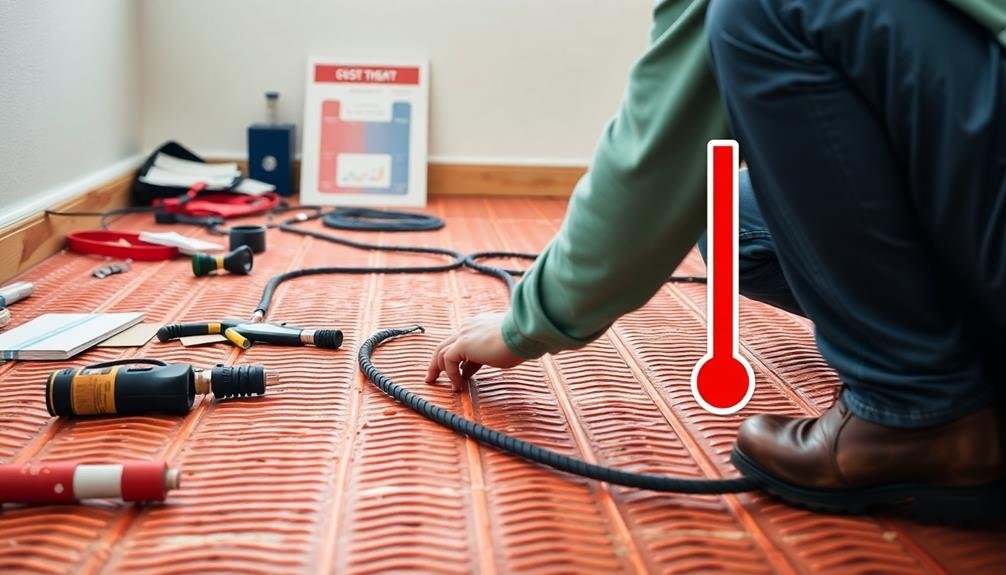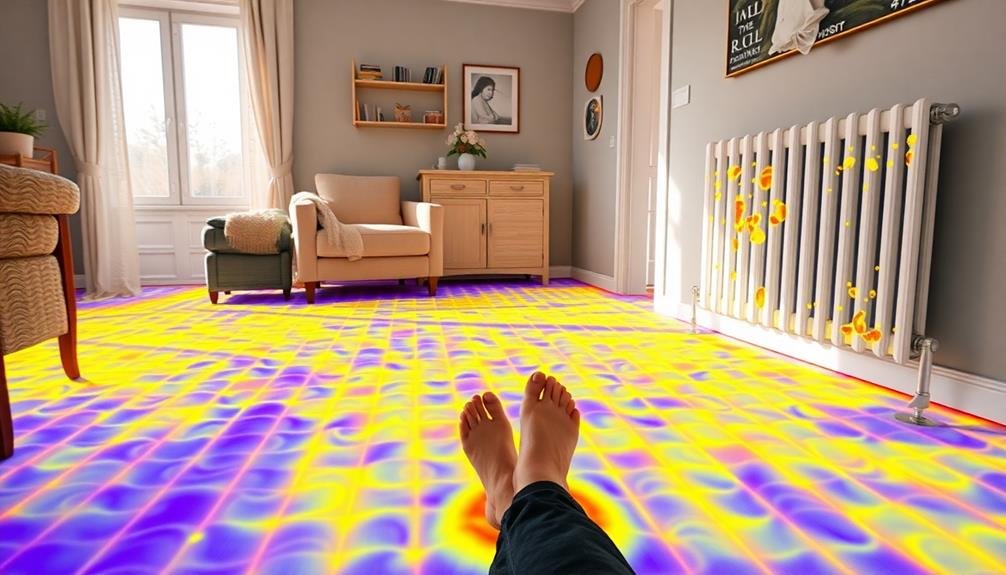Affordable radiant floors offer exceptional home comfort while slashing energy costs by up to 30%. You'll enjoy even, consistent warmth throughout your living spaces without the noise and dust circulation of traditional heating systems. These efficient systems work at lower temperatures, reducing your reliance on fossil fuels and potentially lowering your carbon footprint. They're compatible with most flooring types and can be installed in both new and existing homes. With minimal maintenance required and long-term energy savings, radiant floors can increase your home's value and appeal to potential buyers. Discover how this innovative heating solution can transform your living experience and save you money.
Energy Efficiency of Radiant Floors

Radiant floors' energy efficiency is one of their most compelling features. They distribute heat evenly throughout your home, eliminating cold spots and reducing the need for higher thermostat settings.
Unlike forced-air systems that can lose heat through ductwork, radiant floors transfer warmth directly to objects and people in the room, minimizing energy waste.
You'll find that radiant floors work efficiently with various heat sources, including boilers, heat pumps, and solar thermal systems. They operate at lower temperatures than traditional heating methods, which can lead to significant energy savings.
The thermal mass of the floor helps retain heat, allowing your system to run less frequently and maintain consistent comfort.
Radiant floors also improve indoor air quality by eliminating the circulation of dust and allergens associated with forced-air systems. This can reduce your reliance on air filtration devices, further saving energy.
Additionally, the absence of noisy fans or blowers means you won't be tempted to crank up the heat to overcome drafts or uneven temperatures.
Types of Affordable Radiant Systems
When considering affordable radiant floor heating, you'll encounter two main types: electric and hydronic systems.
Electric systems use heating cables or mats, while hydronic systems circulate heated water through pipes.
You can also explore retrofit options that don't require extensive floor modifications, making radiant heating more accessible for existing homes.
Electric vs. Hydronic Systems
There are two main types of affordable radiant floor heating systems: electric and hydronic. Electric systems use resistance cables or mats installed beneath your flooring, while hydronic systems circulate heated water through a network of pipes.
Electric systems are typically easier and less expensive to install, especially in smaller areas or during renovations. They're ideal for bathrooms, kitchens, or single rooms. Hydronic systems, on the other hand, are more cost-effective for whole-house heating and can be integrated with your existing water heater or boiler.
Here's a comparison of electric and hydronic radiant floor systems:
| Feature | Electric | Hydronic |
|---|---|---|
| Installation Cost | Lower | Higher |
| Operating Cost | Higher | Lower |
| Efficiency | Good | Excellent |
| Maintenance | Minimal | More Complex |
When choosing between electric and hydronic systems, consider your home's size, your budget, and your long-term energy costs. Electric systems offer quick installation and zoned heating, while hydronic systems provide consistent, efficient warmth throughout your home. Ultimately, your choice will depend on your specific needs and preferences.
Retrofit Options Available
Interested in adding radiant floor heating to your existing home? You've got several affordable retrofit options to evaluate.
Electric radiant mats are a popular choice for existing homes. These thin, flexible mats can be installed directly under tile, laminate, or engineered wood flooring. They're ideal for smaller areas like bathrooms or kitchens, and they don't require significant floor height adjustments.
For larger spaces, you might opt for electric radiant film. This ultra-thin heating element can be installed under carpet or floating floors, making it a versatile choice for living rooms or bedrooms.
If you're renovating and can access the subfloor, think about installing hydronic radiant tubing between floor joists. This method doesn't raise your floor height and can be more energy-efficient for whole-house heating.
Another option is low-profile hydronic panels that sit on top of your existing subfloor. These panels are only about half an inch thick and can be covered with various flooring materials.
They're a good compromise between performance and ease of installation, especially if you can't access your subfloor easily.
Installation Process and Costs

You'll find that installing radiant floors involves a series of precise steps, from preparing the subfloor to laying the heating elements.
To reduce costs, you can employ techniques like zoning systems or using alternative materials.
While professional installation guarantees peak performance, a DIY approach might be feasible for some homeowners with the right skills and tools.
Step-By-Step Installation Guide
Installing radiant floors involves five key steps that homeowners can follow for a successful DIY project.
First, prepare the subfloor by making certain it's clean, level, and structurally sound.
Next, install insulation boards to enhance energy efficiency and heat distribution.
Then, lay out the heating cables or tubing according to your room's layout, securing them to the insulation boards.
The fourth step is to connect the heating elements to the thermostat and power source, following manufacturer guidelines and local electrical codes.
Finally, cover the heating system with your chosen flooring material, such as tile, hardwood, or laminate.
Throughout the installation process, keep these essential tips in mind:
- Measure your room accurately to determine the correct amount of materials needed.
- Use a multimeter to test the heating elements before and after installation.
- Consider hiring a professional electrician for the final connections to guarantee safety.
Cost-Saving Installation Techniques
While radiant floor heating can be a significant investment, there are several cost-saving techniques you can employ during the installation process.
Start by carefully planning your project and researching local suppliers to find the best deals on materials. You'll often save money by purchasing components in bulk.
Consider a DIY approach for simpler installations, especially if you're handy with tools. However, for more complex systems, it's wise to hire a professional to guarantee proper installation and avoid costly mistakes.
If you do hire a contractor, get multiple quotes and ask about any available off-season discounts.
Opt for electric radiant heating in smaller areas or rooms you don't use frequently, as it's generally less expensive to install than hydronic systems.
For larger spaces, hydronic systems may be more cost-effective in the long run due to lower operating costs.
Use reflective insulation beneath the heating elements to improve efficiency and reduce heat loss. This can lower your energy bills over time.
Professional Vs DIY Installation
When considering radiant floor heating, one of the biggest decisions you'll face is whether to opt for professional installation or take the DIY route.
Professional installation offers expertise and efficiency but comes at a higher cost. You'll benefit from experienced technicians who can quickly and accurately install your system, ensuring peak performance. They'll also handle any unexpected issues that may arise during installation.
On the other hand, DIY installation can greatly reduce costs if you're handy and willing to invest time and effort. However, it requires careful planning and execution to avoid costly mistakes.
Before deciding, consider these factors:
- Complexity of your project: Simple, single-room installations are more suitable for DIY, while whole-house systems may require professional help.
- Your skill level and available time: Assess your abilities and whether you can dedicate sufficient time to complete the project.
- Local building codes and permits: Professionals are familiar with regulations, while DIY installers must research and comply with local requirements.
Ultimately, weigh the potential savings against the risks and time investment of DIY installation.
If you're confident in your abilities and have a straightforward project, DIY can be a cost-effective option. For complex systems or if you value peace of mind, professional installation may be worth the extra cost.
Comfort Benefits for Homeowners
For homeowners seeking ultimate comfort, radiant floors offer a luxurious solution. You'll experience consistent, even heat throughout your living spaces, eliminating cold spots and drafts. Unlike forced-air systems, radiant heating doesn't circulate dust or allergens, improving indoor air quality and reducing respiratory issues.
You'll appreciate the silent operation of radiant floors, as there's no noisy furnace or blowing air to disrupt your peace. The gentle warmth rising from the floor creates a cozy atmosphere, making walking barefoot a pleasure, even on tile or stone surfaces.
This efficient heating method also allows you to maintain a lower overall room temperature while still feeling comfortable, potentially lowering your energy bills.
Radiant floors provide versatility in furniture placement since you won't need to worry about blocking heat vents or radiators. The invisible heating system preserves your home's aesthetics, and you can enjoy more usable space without visible heating elements.
Additionally, the even heat distribution helps prevent moisture issues, reducing the risk of mold growth and protecting your home's structure and your family's health.
Maintenance and Long-Term Savings

Beyond the immediate comfort benefits, radiant floor heating systems offer impressive advantages regarding maintenance and long-term savings. You'll find that these systems require minimal upkeep compared to traditional heating methods. With no filters to replace or ductwork to clean, you'll save time and money on routine maintenance tasks.
The long-term savings of radiant floor heating are substantial. Here's why:
- Energy efficiency: Radiant systems heat objects directly, reducing heat loss and lowering energy consumption.
- Zoning capabilities: You can easily control temperatures in different areas of your home, heating only the spaces you're using.
- Increased home value: Radiant floor heating is an attractive feature for potential buyers, potentially boosting your property's resale value.
You'll also appreciate the system's longevity. With proper installation, radiant floor heating can last for decades, often outlasting conventional HVAC systems.
This durability means you won't need to worry about frequent replacements or repairs. Additionally, the even heat distribution reduces stress on the system, further extending its lifespan.
Compatibility With Existing Flooring
Many homeowners wonder about installing radiant floor heating with their existing flooring. The good news is that radiant heating systems are compatible with most flooring types, offering you flexibility in your home design.
If you have hardwood floors, you'll be pleased to know that engineered wood works well with radiant heating. It's more stable than solid hardwood and less prone to warping.
Tile and stone are excellent conductors of heat, making them ideal choices for radiant systems. They'll efficiently transfer warmth to your living space.
For those with carpeted rooms, you can still enjoy radiant heating. Opt for low-pile carpets with a lower tog rating to allow better heat transfer.
Vinyl and laminate flooring are also compatible, but check with the manufacturer for specific recommendations.
If you're considering a new floor installation, inform your contractor about your radiant heating system. They'll guarantee proper installation techniques are used.
For existing floors, a professional can assess whether your current flooring is suitable or if modifications are needed.
DIY Options for Radiant Heating

While professional installation is often recommended, homeowners with DIY experience can tackle some radiant heating projects themselves. Electric radiant heating mats or cables are the most accessible options for DIY installation, particularly in smaller spaces like bathrooms or kitchens. These systems can be laid directly under tile, stone, or engineered wood flooring, making them a popular choice for renovation projects.
Before starting on a DIY radiant heating installation, you'll need to:
- Assess your skill level and willingness to learn about electrical work
- Research local building codes and obtain necessary permits
- Carefully plan the layout, including thermostat placement and power requirements
If you're comfortable with the process, you can save on labor costs by installing the heating elements yourself. However, it's essential to have a licensed electrician connect the system to your home's power supply.
Remember that DIY installation may void some warranties, so weigh the pros and cons carefully. For larger projects or hydronic systems, it's best to leave the installation to professionals to guarantee safety and peak performance.
Environmental Impact of Radiant Floors
Radiant floor heating systems offer three key environmental benefits compared to traditional forced-air heating.
First, they're more energy-efficient, reducing your carbon footprint. You'll use less energy to heat your home because radiant floors distribute heat evenly and maintain consistent temperatures. This efficiency can lead to lower energy bills and decreased reliance on fossil fuels.
Second, radiant floors improve indoor air quality. Unlike forced-air systems that circulate dust, allergens, and pollutants, radiant heating doesn't rely on air movement. This means you'll breathe cleaner air, potentially reducing respiratory issues and allergies.
Lastly, radiant floors are compatible with renewable energy sources. You can easily integrate them with solar or geothermal systems, further reducing your environmental impact. By using clean energy to power your radiant floors, you'll greatly decrease your home's carbon emissions.
When choosing radiant floor heating, you're not just investing in comfort; you're making an environmentally responsible decision.
These systems offer long-term sustainability benefits, helping you reduce your ecological footprint while enjoying a cozy, efficient home. Consider radiant floors as a green alternative for your heating needs.
Comparing Radiant to Traditional Heating

When comparing radiant floor heating to traditional systems, several key differences emerge.
You'll notice that radiant heating provides a more even and comfortable warmth throughout your home. Unlike forced-air systems, which can create drafts and temperature fluctuations, radiant floors maintain a consistent temperature from floor to ceiling. This results in improved comfort and potentially lower energy bills.
Another advantage of radiant heating is its silent operation. You won't hear the noise of a furnace kicking on or air rushing through vents. This creates a more peaceful living environment, especially in bedrooms and living areas.
Radiant floors also offer benefits for indoor air quality and home design:
- Reduced dust circulation compared to forced-air systems
- No visible heating units, allowing for more flexible furniture placement
- Improved humidity control, helping to prevent dry air issues in winter
While traditional heating systems may be more familiar, radiant floors provide a superior heating experience.
They're energy-efficient, comfortable, and can add value to your home. When considering a heating upgrade, don't overlook the many advantages of radiant floor heating.
Frequently Asked Questions
Can Radiant Floors Be Installed in Multi-Story Homes?
Yes, you can install radiant floors in multi-story homes. They're suitable for any level, including basements and upper floors. You'll need proper planning and installation to guarantee efficient heat distribution throughout each story of your house.
Are Radiant Floors Suitable for Homes in Extremely Cold Climates?
Yes, radiant floors are excellent for homes in extremely cold climates. They'll keep your feet warm and distribute heat evenly throughout your space. You'll love how they maintain a consistent temperature, even in the harshest winter conditions.
How Long Does It Take for Radiant Floors to Heat Up?
You'll find radiant floors typically heat up within 30-60 minutes. They're slower than forced air systems but provide more consistent warmth. Once warm, they maintain temperature efficiently, keeping you cozy throughout the day.
Can Radiant Floors Be Used for Cooling in Summer Months?
You can use radiant floors for cooling, but it's less common and efficient than heating. They'll circulate cool water through pipes, removing heat from your home. However, it's usually more practical to rely on traditional air conditioning systems.
Are There Any Health Benefits Associated With Radiant Floor Heating?
Yes, radiant floor heating can offer health benefits. You'll experience improved air quality due to reduced dust circulation. It's also gentle on your respiratory system and can alleviate allergies. The consistent warmth may even boost your comfort and well-being.
In Summary
You've seen how affordable radiant floors can transform your home's comfort. They're energy-efficient, easy to install, and work with various flooring types. You'll enjoy consistent warmth and lower energy bills. With DIY options available, you can even tackle the project yourself. Remember, radiant heating isn't just about comfort; it's an eco-friendly choice that'll serve you well for years to come. Consider making the switch—your feet will thank you!





Leave a Reply